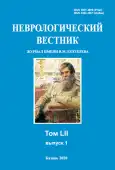The burden attributable to substance use in the Russian Federation
- Authors: Soshnikov S.S.1, Starodubov V.I.1, Khaltourina D.A.1, Vlassov V.V.2, Obuhova O.V.1, Idrisov B.T.1,3
-
Affiliations:
- Federal Research Institute for Health Organization and Informatics of Ministry of Health of the Russian Federation
- National Research University Higher School of Economics
- Federal State Budgetary Educational Institution of Higher Education Bashkir State Medical University of the Ministry for Healthcare of the Russian Federation
- Issue: Vol LII, No 1 (2020)
- Pages: 49-54
- Section: Original study arcticles
- URL: https://journals.rcsi.science/1027-4898/article/view/18975
- DOI: https://doi.org/10.17816/nb18975
- ID: 18975
Cite item
Full Text
Abstract
Aim. Assessment of the health consequences of substance use in the form of lost years of healthy life in the world in comparison with Russia. An additional task was to determine the economic losses from alcohol, tobacco and drugs in the Russian Federation.
Methods. We used indicators of mortality, morbidity, prevalence, and years of life lost, taking into account the DALY disability from tobacco, alcohol, opiates, cannabis, and other drugs (ICD10: I42.6, K70.03, Z72.0, F10-19). Indicators of harmful health effects from PS were presented from 1990 to 2017. Variables were standardized by age and sex. An economic assessment of the impact of tobacco, alcohol, and drugs denominated in rubles was applied.
Results. Total economic losses from psychoactive substances, expressed in rubles, amounted to from 887.4 billion to 8.5 trillion rubles in Russia in 2017. The greatest harmful effects on health from psychoactive substances in Russia and the world are caused by tobacco, with alcohol in the second place. The damage from smoking in Russia in years of lost life including disability DALY amounted to 8.6 million in 2017 Alcohol consumption and its consequences in Russia caused 1.85 million DALYs of harm to health, alcoholic cirrhosis and other liver diseases-643 thousand DALYs.
Conclusion. Alcohol and nicotine cause maximum harm to the health and economy of Russia, and in conditions of limited resources, the main efforts should be directed at preventing the consequences of alcoholism and tobacco smoking.
Full Text
##article.viewOnOriginalSite##About the authors
Sergej S. Soshnikov
Federal Research Institute for Health Organization and Informatics of Ministry of Health of the Russian Federation
Email: s.soshnikov@yahoo.com
Russian Federation, 127254, Moscow, Dobrolubov str., 11
Vladimir I. Starodubov
Federal Research Institute for Health Organization and Informatics of Ministry of Health of the Russian Federation
Email: s.soshnikov@yahoo.com
Russian Federation, 127254, Moscow, Dobrolubov str., 11
Dar’ya A. Khaltourina
Federal Research Institute for Health Organization and Informatics of Ministry of Health of the Russian Federation
Email: s.soshnikov@yahoo.com
Russian Federation, 127254, Moscow, Dobrolubov str., 11
Vasilij V. Vlassov
National Research University Higher School of Economics
Email: vvvlas@gmail.com
Russian Federation, 109028, Moscow, Pokrovski Blvd, 11
Ol’ga V. Obuhova
Federal Research Institute for Health Organization and Informatics of Ministry of Health of the Russian Federation
Email: bidrisov@gmail.com
Russian Federation, 127254, Moscow, Dobrolubov str., 11
Bulat T. Idrisov
Federal Research Institute for Health Organization and Informatics of Ministry of Health of the Russian Federation; Federal State Budgetary Educational Institution of Higher Education Bashkir State Medical University of the Ministry for Healthcare of the Russian Federation
Author for correspondence.
Email: bidrisov@gmail.com
Russian Federation, 127254, Moscow, Dobrolubov str., 11; 50008, Ufa, Lenin str., 3
References
- Degenhardt L., Charlson F., Ferrari A. et al. The global burden of disease attributable to alcohol and drug use in 195 countries and territories, 1990–2016: a systematic analysis for the Global Burden of Disease Study 2016. Lancet Psychiatry. 2018; 5 (12): 987–1012.
- Griswold M.G., Fullman N., Hawley C. et al. Alcohol use and burden for 195 countries and territories, 1990–2016: a systematic analysis for the Global Burden of Disease Study 2016. Lancet. 2018; 392 (10 152): 1015–1035.
- James S.L., Abate D., Abate K.H. et al. Global, regional, and national incidence, prevalence, and years lived with disability for 354 diseases and injuries for 195 countries and territories, 1990–2017: a systematic analysis for the Global Burden of Disease Study 2017. Lancet. 2018; 392 (10 159): 1789–1858.
- Kyu H.H., Abate D., Abate K.H. et al. Global, regional, and national disability-adjusted life-years (DALYs) for 359 diseases and injuries and healthy life expectancy (HALE) for 195 countries and territories, 1990–2017: a systematic analysis for the Global Burden of Disease Study 2017. Lancet. 2018; 392 (10 159): 1859–1922.
- Roth G.A., Abate D., Abate K.H. et al. Global, regional, and national age-sex-specific mortality for 282 causes of death in 195 countries and territories, 1980–2017: a systematic analysis for the Global Burden of Disease Study 2017. Lancet. 2018; 392 (10 159): 1736–1788.
- GBD, Global Burden of Diseases study protocol. Version 3.0; Issued 26 February 2018. Institute for Health Metrics and Evaluation. http://www.healthdata.org/gbd/about/protocol (access date: 01.03.2020).
- WHO. Metrics: Disability-Adjusted Life Year (DALY). 2019. https://www.who.int/healthinfo/global_burden_disease/metrics_daly/en/ (access date: 01.03.2020).
- Могилевская А. За год «стоимость» жизни россиян выросла на 1 млн руб. Росбизнесконсалтинг. https://www.rbc.ru/economics/27/06/2017/59523d3c9a7947d75f8792bf (дата об- ращения: 01.03.2020).
- Зубец А. «Стоимость» человеческой жизни в России с учётом морального ущерба в начале 2018 года поднялась до 46,9 млн рублей. Исследование Финансового университета при Правительстве РФ. http://www.fa.ru/org/div/cos/press/Documents/58_Life_Value_2018.pdf (дата обращения: 01.03.2020).
- Archie S.R., Cucullo L. Harmful effects of smoking cannabis: A cerebrovascular and neurological perspective. Front. Pharmacol. 2019; 10: 1481.
- Aebi M.F., Hashimoto Y.Z., Tiago M.M. Probation and Prisons in Europe, 2018: Key findings of the SPACE reports. http://wp.unil.ch/space/files/2019/05/Key-Findings_SPACE-II_190520-1.pdf (access date: 01.03.2020).
- Антонян Ю.М., Бражников Д.А., Гончарова М.В. и др. Комплексный анализ состояния преступности в Российской Федерации и расчётные варианты её развития. ФГКУ «ВНИИ МВД России». 2018. https://mvd.ru/upload/site163/document_text/Kompleksnyy_analiz__original-maket_24_04.pdf (дата обращения: 01.03.2020).
Supplementary files









